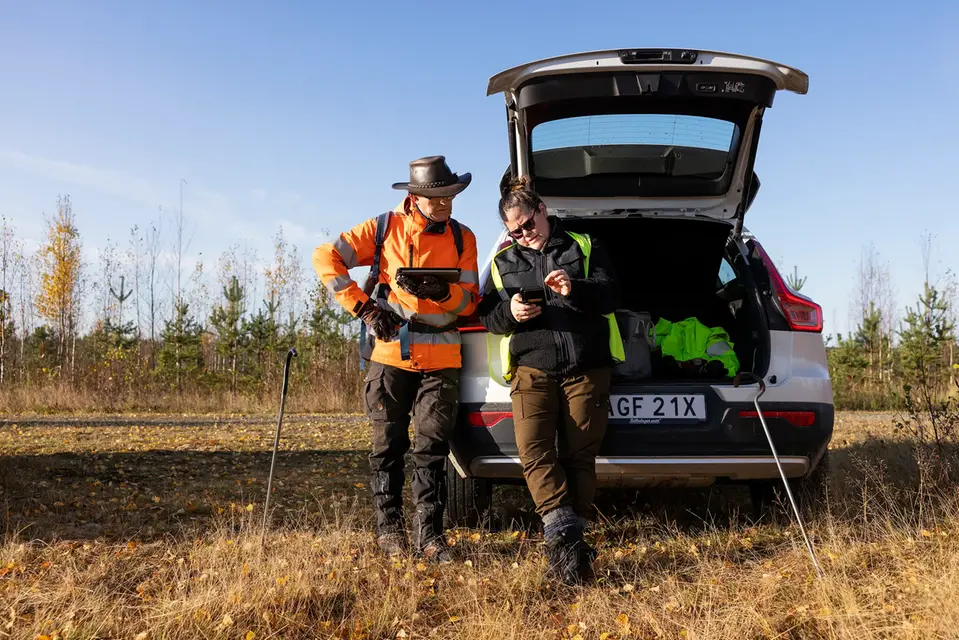Moving here
New rail reveals traces of the past
In a few years, the rails of the Norrbotten Line will cross forests and marshes in Skellefteå municipality. But what is hidden along the route? What human activities have taken place there over the years? Before a new rail is laid, old tracks must be examined.
Therese Hellqvist and Olof Östlund step over stumps and pits left by forestry machines in a clearcut north of Ersmark. Equipped with advanced digital maps on their mobile phones, and a soil probe that acts as both a stick and a tool for taking soil samples, they move towards natural heights in the terrain. The duo work as archaeologists at Skellefteå Museum, but right now they are on assignment from the county administrative board. They are conducting an investigation where they are inventorying the proposed corridor for the Norrbotten Railway. Therese and Olof have been assigned the stretch between Medle and Ersmark and are laboriously trudging through more or less impenetrable vegetation in search of traces of human activity.
- It's about seeing both far and short. You look out over the landscape and wonder where people might have lived thousands of years ago," says Olof when he reaches the top and looks around. He imagines previous eras. The retreat of the inland ice, the eastward movement of the coastline.
- Where might there have been a bay or waterways nearby? Do I see anything in the surroundings that could be an ancient site, like a building that stands out? And if I look even closer, perhaps in a furrow, can I see anything there? Any quartz deposits or shards of stone that might indicate that someone made tools here," says Olof.
It is easy to dream away.
- I think all archaeologists are drawn to the allure of never knowing for sure what they will find and the curiosity to understand their past, the past. To put the puzzle together. Getting answers to what, how and perhaps why. To walk for a brief second in the footsteps of ancient man. It creates a certain affinity and added value," says Therese.
The entire route has been inventoried before, but there is always something that has been missed and new information or knowledge may have been added. This, in combination with tips from the public but also place names, means that the archaeologists have a pretty good idea of where to focus their attention.
- 'We are learning more about ancient remains. We now know things we didn't know in the 1970s and can see things with new eyes," says Olof.
He is a living example of this. Archaeological circles in southern Sweden used to assume that northern Sweden was uninhabited in ancient times and that the first people migrated from the south. Thanks to the discovery of a settlement outside Pajala, which Olof was involved in, it was possible to show that people had been living in the area for over 10 000 years and that they probably migrated from the west and north. As a result, the entire history of when and how Sweden was populated had to be rewritten. And for Olof it became something of a niche to specialize in the first inhabitants of the north.
A find like the one above is extremely rare. What archaeologists can usually expect to find in our region are burial mounds, stone settlements, trapping pits, Bronze, Stone and Iron Age settlements, and perhaps the occasional medieval house foundation.
- As an archaeologist here, you become an expert on the ancient history of northern Sweden and what you are particularly interested in: a particular period or phenomenon - such as rock art, hunting and trapping. Usually it's a combination of both," says Therese.
The two-week-long inventory has yielded four concrete finds: two Stone Age settlements, a shelter of Sami construction made of stones - probably from after the 16th century - but also an interesting stone quarry.
- We must follow up to date it. It could be a quarry for feldspar, in which case it's modern, but it could also be a quarry for quartz, in which case it's from the Stone Age," says Olof, explaining that the definition of ancient remains is that they must be the remains of human activity in the past, they must have been created through the use of older times and be permanently abandoned. They must also have been created before 1850.
So what is the dream find?
- It is probably not the gold treasure, as many would probably think, but rather something that provides new knowledge, that writes new history. Whether it's a house, individual finds or something as simple as a pile of rubbish," says Therese.
More finds are likely to follow in a rapidly expanding Skellefteå. The archaeologists here have never been as busy as they are now. But why is it important to spend time, effort and resources on things that have been buried for a long time?
- Archaeology works to preserve, investigate and communicate the past to the present. To know where we are going, we need to know where we have been. Otherwise we will be without history. I don't think that's good for any group, society or civilization," says Therese.

Sidinformation
- Senast uppdaterad:
- 18 December 2023

